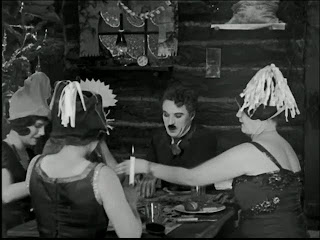 |
| http://www.moviegoods.com/Assets/product_images/ 1010/525992.1010.A.jpg |
Another few key aspects to Charlie Chaplin's character was his tramp costume and having a woman see the tramp's redeeming qualities. In The Gold Rush, he wears oversized shoes, baggy pants, a tight coat, a small bowlers cap, and a cane. Georgia, even though it took her the whole film, realized that the lone prospector was the "nice guy". As for Chaplin's cinematic style, he used unobtrusive editing. In the film, he had continued shots and cuts. There was no enhanced tertiary effects, like fades and overlaps.
2. The article, Charlie Chaplin and Dreams, by David Lemaster in The Journal of Popular Film & Television looks into why Charlie Chaplin The Tramp, used specific aesthetics, like dream sequences, throughout his career. Charlie wanted to develop a sense of pathos between his character and the audience. His character was meant to portray the "American Dream", which was a character that had hopes and dreams, but at the same time had a fear of failure. The character could relate to all audience because he was below the socioeconomic level and could dream at the same time. In Chaplin's Films, he used two types of dream sequences: full scale dreams and daydreams. Dreams were used in films, such as His Prehistoric Past, The Bank, Shoulder Arms, and The Kid, to disrupt the film long enough to go into an alternative reality. Using daydreams in films, such as Sunnyside, The Idle Castle, and The Circus, Charlie was able to fantasize about overcoming obstacles. He would do this by certain film techniques or a sate of sleeping. These two aspects were essential for creating the relationship between himself and the audience. Because these sequences were universal, the audience was drawn in more and could relate more with Chaplin's characters.
 |
| http://readingeagle.com/BlogUploads/68/gold%20rush%20charlie.jpg |
3. This article relates to the Gold Rush because Charlie Chaplin uses a daydream and a dream sequence. Usually Chaplin does the daydream sequences on his own, but Big Jim McKay takes this part. The Lone Prospector, played by Chaplin, and Big Jim Mckay are stuck in a cabin together during the gold rush in Alaska due to a snow storm. The two are waiting for Black Larsen, a wanted criminal who lives in the cabin, to come back with food. After Black doesn't return, they both become very hungry. They have to resort to other sources of food, like The Loan Prospector's shoe. Big Jim McKay starts daydreaming that The Loan Prospector is a chicken and tries to kill him. The film uses a short dream when The Lone Prospector falls asleep at his table waiting for Georgia and her friends. They promised to come on New Years Eve at 8 p.m. He fell asleep after waiting and waiting for them, but they never showed. He dreamt about Georgia and her friends actually coming to dinner and he entertains them with a dance.
4. The Gold Rush is entirely still a classic. Its place in history is perfect because The Great Depression was taking place. The tramp's character represents and relates to every person struggling. During the depression people were yearning for money and being happy. Most of all, the tramp was an outsider and an underdog, and people felt like that during this time period. With its great comedy, people were able to laugh and escape from what was going on around them. The overall directing by Charlie Chaplin had a very distinct style. The scenes and editing were clean and to the point. There were no fancy zooms or transitions either. The only time he did an extreme close up was when he wanted to show true emotion. The story line was very clear, concise, and in a continued circular pattern. For the films place in history, it had good clean comedy, a great story line, and talented actors. As the photo says above, The Gold Rush is "the world's great laughing picture." It truly is one of them.

No comments:
Post a Comment